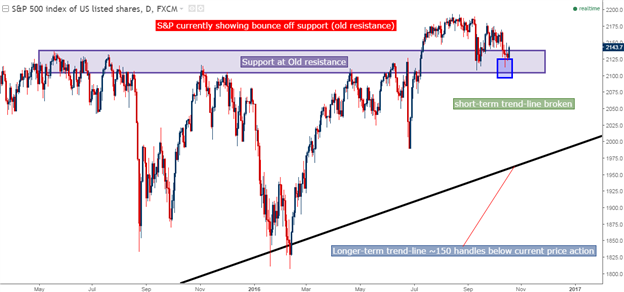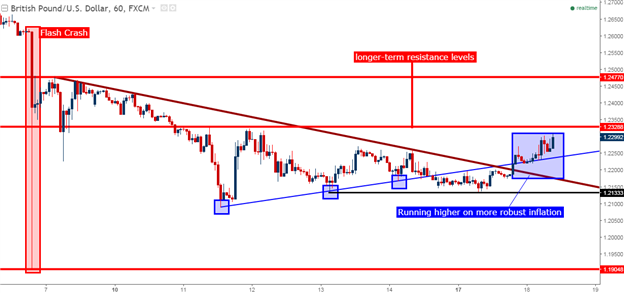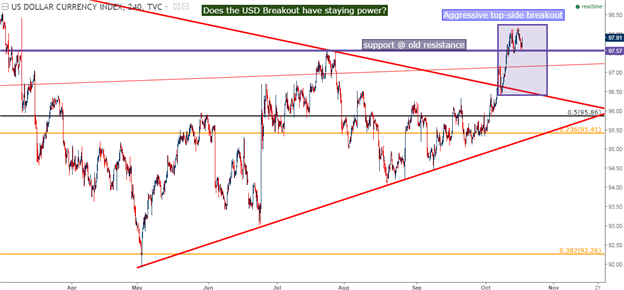Talking Points:
- Inflation numbers were released out of both the U.S. and U.K. this morning, with both showing signs of gains from previous months’ prints.
- The more interesting observation has been out of the U.K. as inflation is beginning to show after the ‘sharp repricing’ in the value of the British Pound. Could further gains in inflation eventually move the BoE’s hand away from additional dovish measures?
-If you’re looking for trading ideas, check out our Trading Guides. They’re free-for-all and updated for Q4.
To receive James Stanley’s Analysis directly via email, please sign up here.
The big data points of the morning have been inflationary prints out of the U.S. and the U.K; with both showing gains compared to prior prints. Inflation for the month of September in the United States printed at 1.5% versus last month’s 1.1% number; core inflation came in at 2.2%, a bit below the expectation which was the same as last month’s print of 2.3%.
In the U.K, inflation came in above expectations, printing at 1% versus an expectation of .9% and a prior print of .6%; while core inflation showed at 1.5% versus an expectation of 1.4% and a prior print of 1.3%.
The big takeaway from this morning’s data is the fact that inflation has begun to creep-in to the U.K. economy after the ‘sharp repricing’ in the value of the British Pound around the Brexit referendum; while the United States remains on a path to stable, increasing, albeit weaker-than-desired inflation. The net result of these more robust inflationary prints have seen global stock prices move higher, and we’re looking at the bounce off of support in the S&P 500 this morning.

Chart prepared by James Stanley
But higher inflation doesn’t necessarily amount to trends in a currency, does it? While inflation is often a direct driver of spot rates, this relationship doesn’t always hold true. The more prominent driver of currency prices are interest rates. In a normal environment, interest rates will be adjusted based on inflation; with rates moving higher as inflation ticks up and rates driven lower as inflation tones-down. This can also carry impact across markets, such as equities or even commodities; as higher rates that often come with stronger inflation makes for a more difficult or ‘tighter’ operating environment.
So, while inflation usually displays a type of direct relationship with prices, there’s a middle-man (or woman) here: The Central Bank that devises rate policy based on inflation and/or employment expectations. And that’s where the water begins to get muddied at the moment regarding both the U.S. and U.K. economies.
The Bank of England has been clear that they can ‘do more’ in the effort of offsetting risks from Brexit. So far this has included a rate cut along with a ‘bazooka of stimulus,’ but still the bank pledges that they can do even more. Analysts are widely expecting another interest rate cut to .1% at a near-dated meeting; but once rates get that low there is a big question about what next steps might be available. Mark Carney, Governor of the Bank of England, has previously spoken-out against negative interest rates, so that doesn’t seem to be on the table. And once they get down to .1%, perhaps they can shed another 10 basis points, but what after that?
Also complicating the picture is the fact that market forces may begin to really start working against the BoE’s dovishness. Just ahead of the referendum Mark Carney warned of the potential consequences of Brexit which could entail ‘higher unemployment, higher inflation, slower growth and a sharp repricing in the value of the British Pound.’ As Mr. Carney outlined, this would put the Bank of England in the unenviable position of having to choose which set of risks to mold policy towards. Should the bank pose higher rates, this could help the value of GBP while also dampening inflation; but this would likely choke growth while also increasing unemployment. Lower rates, on the other hand, may help boost employment and growth figures while running the risk of higher inflation on the back of an extremely weak British Pound.
In the months after the referendum, the BoE’s decision as to which direction to mold policy towards became quite clear. Just days after the Brexit referendum, Mark Carney called an impromptu press conference to warn that rate cuts were coming. The BoE delivered a month later, and a month after that the bank launched a ‘bazooka’ of stimulus that entailed purchasing corporate bonds.
The underbelly of all of these dovish moves is the potential for rising inflation in the British economy; first through imported products and then eventually creeping-in deeper into the domestic economy. This morning’s inflation print may be the early indicator of such a theme; and should inflation continue to increase, this may force the Bank of England’s hand away from future dovish actions.

Chart prepared by James Stanley
U.S. Inflation
Out of the U.S. the picture is a little less muddy. Many members of the Fed have been concertedly-hawkish of recent. Inflation still remains below the bank’s target of 2% (for headline inflation); but the trend is encouraging as inflation has continue to show stable, albeit small gains. So, this morning’s U.S. inflation numbers didn’t do much to drive rate expectations around the Federal Reserve. If you’d like to read more about the details behind the Fed’s stance with inflation at the present, please check out this morning’s market alert around U.S. CPI.
The bigger issue around the United States economy at the moment is the recent breakout in the U.S. Dollar. FOMC hawkishness over the past couple of weeks have helped to drive the greenback to levels not seen since March. If this is a legitimate breakout, price action should find support in the next couple of days before price action moves higher, and a potential support level can be seen around the 97.50 level on DXY (chart below).

Chart prepared by James Stanley
--- Written by James Stanley, Analyst for DailyFX.com
To receive James Stanley’s analysis directly via email, please SIGN UP HERE
Contact and follow James on Twitter: @JStanleyFX






